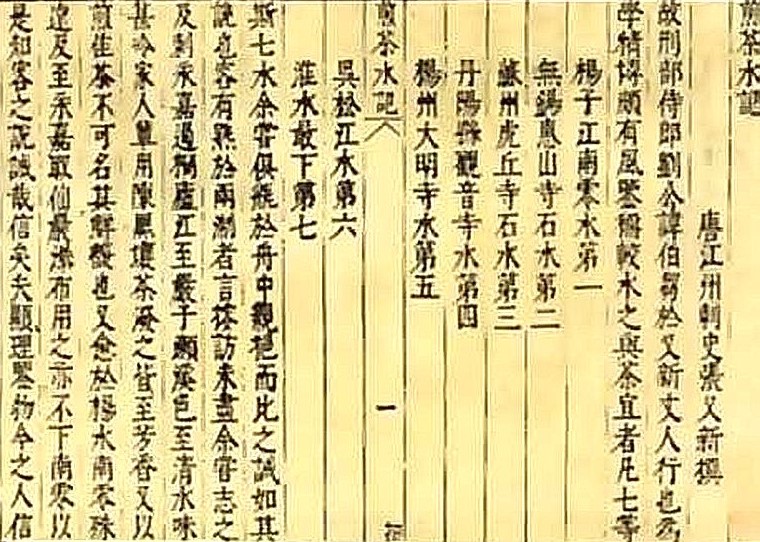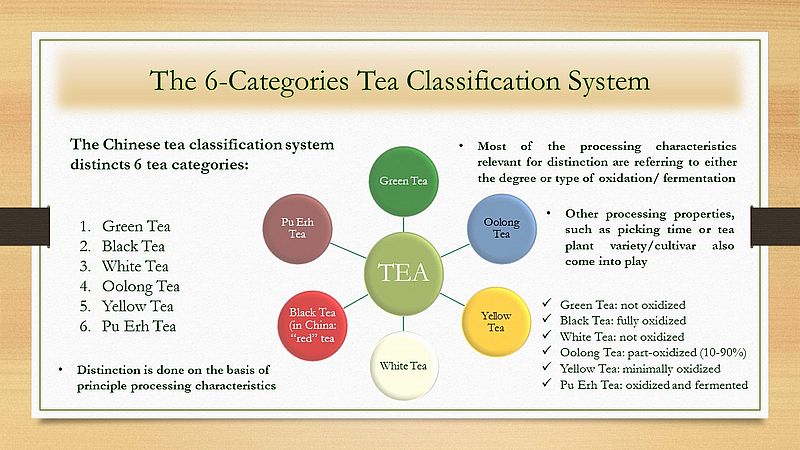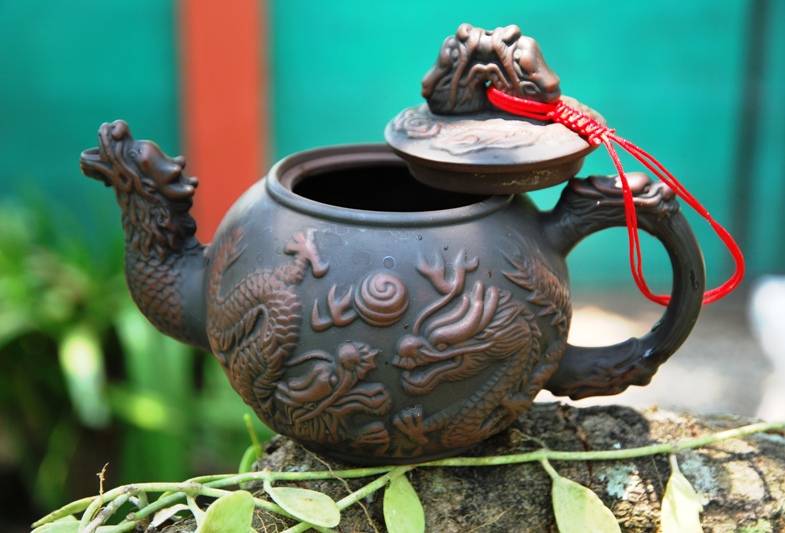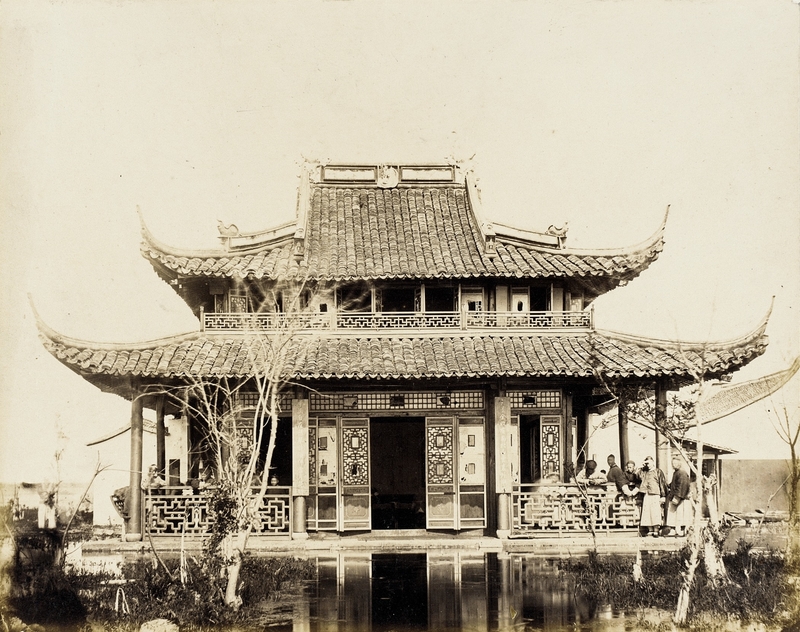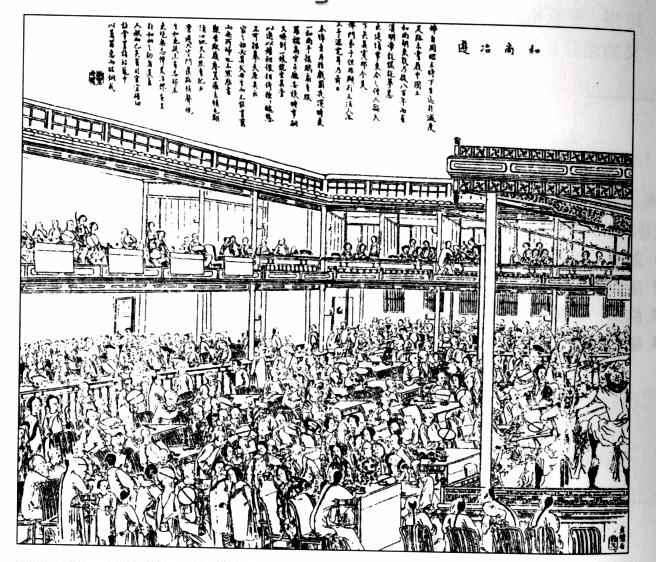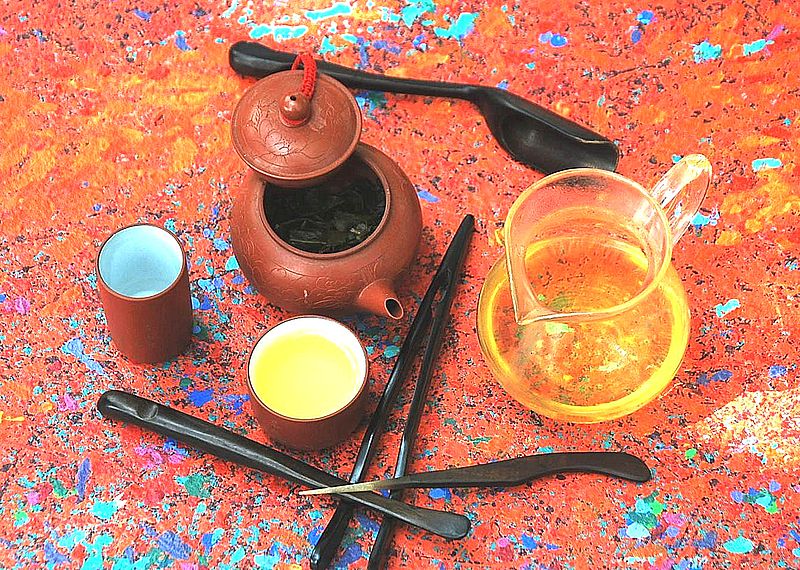1. “Shennong” legend of the discovery of tea
The Chinese legend about the discovery of tea as a beverage takes place on a sunny-weather day in the year 2737 BC. Its main character is a Chinese “emperor” with the name Shennong. According to legend, that Shennong was once sitting in the imperial palace garden, when the wind blew a leaf from a tea tree right into his cup filled with water. Upon trying, the result proved to be a tasty beverage that also showed stimulating effects. From then on, Shennong used his imperial position to promote tea as a beverage among his subjects. So far the legend…
First of all, the name Shennong means something like “Divine Farmer”. Some sources also refer to him as the “ruler of the five seeds”. Accordingly, historical sources point to an early healer, herbalist and agricultural researcher rather than an “emperor”.

Ultimately, the exact facts and details around the person of Shennong are disappearing in the fog of time. However, the story about the very starting point of Chinese tea culture seems to have a true core. That is, there are hints that a person with the name Shennong indeed existed at that time. In fact, the character is revered as the father of herbal medicine and agriculture far beyond China’s borders. So, for example, also in Vietnam, Taiwan and Japan, with temples dedicated to Shennong to be found in each of these countries.
The contents of an early Chinese publication about healing herbs, the Shennong Beng Cao Jing, though compiled long after his time, allegedly is inspired by Shennong’s oral tradition.
2. First physical evidence of the use of tea in China
For a long time, written documentation from the 3rd and 4th century AD were the first evidence of the consumption of tea. However, the recent discovery of the oldest existing tea in the world provides proof of a much earlier use. Furnishings in the grave of the 4th Han emperor Liu Qi and his wife evidently also include tea leaves. The phenomenal about the find is that the emperor buried there lived between 188 and 141 AD. The oldest tea leaves discovered so far had been dating back to the times of the Tang dynasty (618-907 AD).
3. Tea as a medicinal herb in traditional Chinese medicine
However, there is no evidence of whether Liu Qi and his contemporaries consumed their tea for culinary purposes. In fact, though much is pointing to the use of tea leaves at the times of the Han dynasty (206 v. Chr. – 220 AD) already, this might have been mainly for medicinal purposes. Also, tea was actually not infused for such purposes at that time. Rather, one either ate or added powdered tea leaves to a brew or tonic as an ingredient instead. What’s more, it was still unprocessed tea leaves from fresh picking that served for consumption at that time.
4. The beginnings of tea as a beverage in China
Nevertheless, the grave discovery, along with later written mentionings of tea in the times of the Han dynasty, at least suggests that tea might have been known as a culinary treat at that time already. As such, however, it apparantly remained reserved for the nobility caste and the imperial court, hence as a luxury food rather than a semi-luxury food.
From about the 2nd ord 3rd century AD on, tea was also cultivated in China. During the 4th and 5th century then, the popularity of tea as a beverage in China quickly rose. Tea drinking as a habit now prevailed in ever greater circles of China’s “high society”. At that time, it was common to add ingredients such as rice, salt, spices and orange peel when preparing tea.
5. The “Golden Era of Tea”
The time of the Tang dynasty (618-907) is often referred to as the Golden Era of Tea. Tea established as a valuable gift or means of exchange in the highest circles not only at the imperial court and within the Chinese nobility, but also in international diplomatic or trade relations. It was consumed no longer mainly for medicinal purposes now, but increasingly for mere culinary purposes.
The processing standard of that time was the pressing and roasting of green tea leaves. The tea processed in such way, if you want so the most ancient type of Chinese green tea and/or Pu Erh Tea, was then milled to powder and infused with salted or otherwise spiced or flavored boiling water. Notably, two more processing variations also developed during that time. Namely, these were the early forms of what we know as yellow tea and white tea today. Also, a ritualization of the tea preparation as a ceremony or art form is appearing here for the first time. However, the culinary enjoyment of tea remained reserved for the highest circles of society and the imperial court.
6. Lu Yu and the Cha Ching
A milestone product of that time’s tea culture is the literary work “Cha Ching”. Author of the book published in 760 is the Chinese tea sage or “tea saint” Lu Yu (728-804). Lu Yu had been adopted and raised by the imperial court as an intellectually gifted orphan child. After a relevant apprenticeship, he later dedicated his life and work to the research and exploration of tea in all of its aspects. “Cha Ching”, a historical milestone of the emergence of tea as a beverage, literally translates to “The Classic of Tea”. In ten short chapters, the author covers for all important aspects of that time’s tea production and culture. Accordingly reads the table of contents of his work:
1. Chapter I: The origins of tea
2. Chapter II: Instruments for picking and processing tea leaves
3. Chapter III: Processing of the tea leaves
4. Chapter IV: Instruments for preparing the tea
5. Chapter V: Infusing the tea leaves
6. Chapter VI: How to drink tea
7. Chapter VII: Tea in the old texts
8. Chapter VIII: The best tea cultivation regions
9. Chapter IX: Miscellaneous
10. Chapter X: Overview to this work
Excerpt of Lu Yu’s “Cha Ching – the Classic of Tea”
Isn’t it an amazing irony that a book about tea from the year 760 AD contains a chapter with the title “Tea in the old times”? Well, I guess there’s an “old time” from every “modern time’s” perspective…
7. The invention of “Matcha” Tea
The Song dynasty (960-1279) brought a new variant of preparing tea. While so far, finely grinded tea powder had been infused with boiling hot water, it was now frothed up in it. In principle, what we are looking at there is the birth of the Matcha tea. Because, like all types and processing categories of tea, we also owe this one to the Chinese tea culture.
From a nowadays perspective, it might look like Matcha tea being a Japanese invention. On the one hand, Japanese products dominate today’s Matcha market. On the other hand, Matcha is being introduced to us as THE traditional popular beverage No. 1 in Japan. In fact, China knew about frothing up finely powdered green tea with a bamboo whisk already at the times of the Tang dynasty alreay.
However, the processing of Tencha leaves to fine powder (chin.: “Mocha”) and the frothing up of the same in hot water in China soon went out of fashion again. Even pulverized green tea is still – or rather: again – being produced in China today, it doesn’t play an important role there anymore latest since the emergence and victory march of the method of infusing whole tea leaves.
8. Tea as we know it
The 13th and 14th century saw the exploration of oxidation processes and their effects on tea leaves and the resulting tea’s taste. Logical consequence was the development of the processing methods for black tea and Oolong tea. With these introductions, the Chinese 6-categories tea classification system as we know it today was complete. Also, the new processing options led to an even broader, potentially limitless diversification of the Chinese tea portfolio.
At the times of the Ming dynasty (1368-1644) then, the method of tea preparation as we know it today, namely the infusion of whole tea leaves, came up and quickly prevailed. The practical requirements of the new preparation method also brought the development of a new “instrument”, the tea pot, with them. A noteworthy date in this context is the production of the first Yixing teapot in the year 1492.
9. Tea houses and tea rooms
The rising popularity of tea as a beverage was accompanied by the progressive emergence of tea houses and tea rooms in China. There, people did not only meet to drink tea, but also to debate all kinds of problems and matters, whether of personal, social or political nature. The tea houses played an important role in the diffusion of the tea drinking habit in the broader Chinese population. The emergence of publicly accessible tea houses and tea rooms marks the change of the status of tea from a “luxury” foodstuff to a “semi-luxury” foodstuff.
10. The Chinese tea ceremony
In parallel to the development of tea preparation in the form of infusing whole leaves – and in parallel to the emergence of Oolong tea – the Chinese tea ceremony developed. Today, this is one of the best visible symbols of Chinese tea culture. As such, it is anchored across all social classes and walks of life. It consists in the art of focused and to a certain degree ritualized preparation of Oolong tea across several infusions. The goal at this is nothing less than preparing the best – in terms of tastiest – possible Oolong tea. However, the Chinese concept of the tea ceremony is less that of a fixed ritual, but rather that of a flexible and individual process. Hence, both the steps typically performed and the instruments used can vary from region to region as well as on an individual basis.
By the way, China doesn’t really need the rest of world – such as us – to drink all the tea produced in their country. Of the roughly 2 Mio. Tons of domestically produced tea in the year 2014 – almost half of the total world production – China exported only about 200,000 tons. As for the rest, the Chinese drink it all by themselves. And on top of that import even more tea for their own consumption from Taiwan and some countries more.
What’s next?
From China, tea culture spread further across the Asian continent. Lesson 10.3. – The Spread of Tea Culture across Asia looks at the most significant tea cultures emerging with this spread.
One more thing, on my own account…
Do you like this article? Support the maintenance and further development of “My Little Tea School – The ABC of TEA” through your shopping at
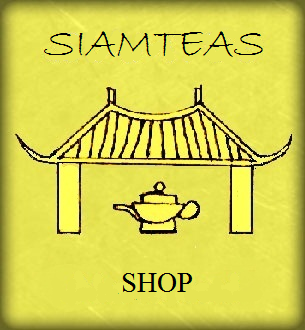
from all over the world






